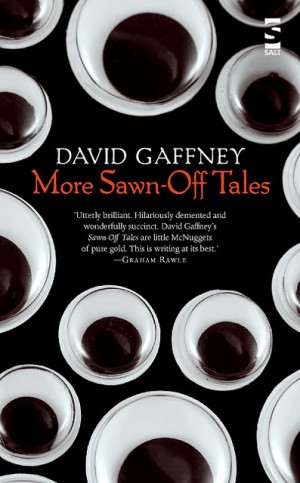You have no items in your cart. Want to get some nice things?
Go shopping More Sawn-Off Tales is the follow up to 2006’s Sawn-Off Tales, but don’t be deceived by its title- there’s nothing haphazard or carelessly truncated about this acerbic and darkly humorous collection of short stories.
More Sawn-Off Tales is the follow up to 2006’s Sawn-Off Tales, but don’t be deceived by its title- there’s nothing haphazard or carelessly truncated about this acerbic and darkly humorous collection of short stories.
With a poet’s eye and an iconoclastic sense of humour, David Gaffney conjures a technologically addled and socially inept world comprised of 69 pieces of flash fiction. There’s a frenetic and imaginative cast of characters contained within: smell comedians, blood spatter analysts, bad and burglarising psychiatrists, feral lambs and alpacas all make an appearance. Each piece is 150 words long, and with punchy openers such as “I helped Ivan load the eyes into his van” or “My penis grew so huge I became house-bound”, Gaffney proves himself to be a master of the surreal, arresting and story-rich first line.
Isolation, in all of its myriad incarnations, as well as the drudgery and inertia of middle-class existence, form the main themes of this collection. These entertaining vignettes are shot through with pathos and a subversive streak of knowing social commentary: this is micro fiction that is aimed for, and also aimed at gently lampooning, a particular kind of smart phone-glued, self-consciously cultured and affected Generation Y set.
Sight & Sound magazine, Sadler’s Wells theatre, Boards of Canada, Detroit techno and “folktronica” artists get name checked- but thankfully these hipster references are passing and humorous and thus do not veer into the realm of elitism or gratuitousness. A deliberate and playful sense of satirical pretension is clearly shown in pieces such as “The Bear’s Head”, where a stuffed bear’s head gets rejected from being placed on a pub wall:
“’It looks left-wing,” the landlord said.
‘’A trendy bear that belongs in a wholefood café, not a pub.’”
In “The Periphery is Everywhere”, a couple engages in a pseudo-intellectual discussion. The conceptual jargon they level at each other serves to inadvertently reveal their inability to actually communicate or fully articulate their estrangement:
“I said her resentment of me was so big I could get inside and walk around.
She said, yes, emotions can have spatial characteristics.
I said experience is an ambulation that concatenates multiple overlapping relations.
She said I was like a cat watching contemporary dance.
I said the felt reality of experience is interwoven at the fringes of perception with the conjunctively structured envelope of waveforms.
She couldn’t think of anything to say to that.”
The humour is sharp and pointed, occasionally a wince or knife-edge away from seriousness. There’s not a word out of place- Gaffney is a writer in full control of his material and there is a wry consistency to the voice and tone of these curious, casually fantastical pieces. Stories veer from quiet hilarity and arch satire into the realm of the macabre, nightmarish and baffling. GoreMen and women struggle to make emotional connections in a series of unusual ways: through living in art installations, dissecting the mechanics of romantic meals, selecting the same paint colour, “Bleached Lichen Number Four”, for their walls, or vegetating outside of the city for the holidays- all to no avail, for “even out here, even in the countryside, they were no closer.”
Gaffney has a gift for unpeeling banality to reveal the absurd and quietly disappointing in the everyday, as this passage from “The Zoo With Three Animals” demonstrates:
“My mother told me about the zoo with three animals. It was called Preston Pleasure Gardens and there was a baboon, a monkey and an ostrich. I thought it was a shame that the baboon and monkey were the same type of animal as it made it appear that the zoo had only two animals. But really it had three.”
Gaffney has been described as “David Shrigley meets Curb Your Enthusiasm” and he does share some similarities with Shrigley in terms of uncovering black humour and absurdity in the everyday. There are also comic shades of Chris Morris and Armando Iannucci. However, Gaffney has a wit and aesthetic that is uniquely his own- the collection is undoubtedly weird, and seems to dwell upon an ocular fixation. Vans and rivers full of eyes are a recurrent motif; perhaps a commentary on an increasingly surveillant society. “The Scientific Explanation for Faraway Eyes” is also explored. The collection tends to read a little repetitively toward the end, but standout pieces such as “The Three Rooms in Valerie’s Head”, “Nothing Can Hurt Me Now” and “It Doesn’t Really Matter If Things Die Out” are terse and funny meditations on love, loneliness and death which invite rereading. Through artful depictions of crumbling or static relationships amidst surreal contexts, Gaffney weaves the everyday and the bizarre with finesse and aplomb.
More Sawn-Off Tales was published in May 2013. Buy it from Foyles.





